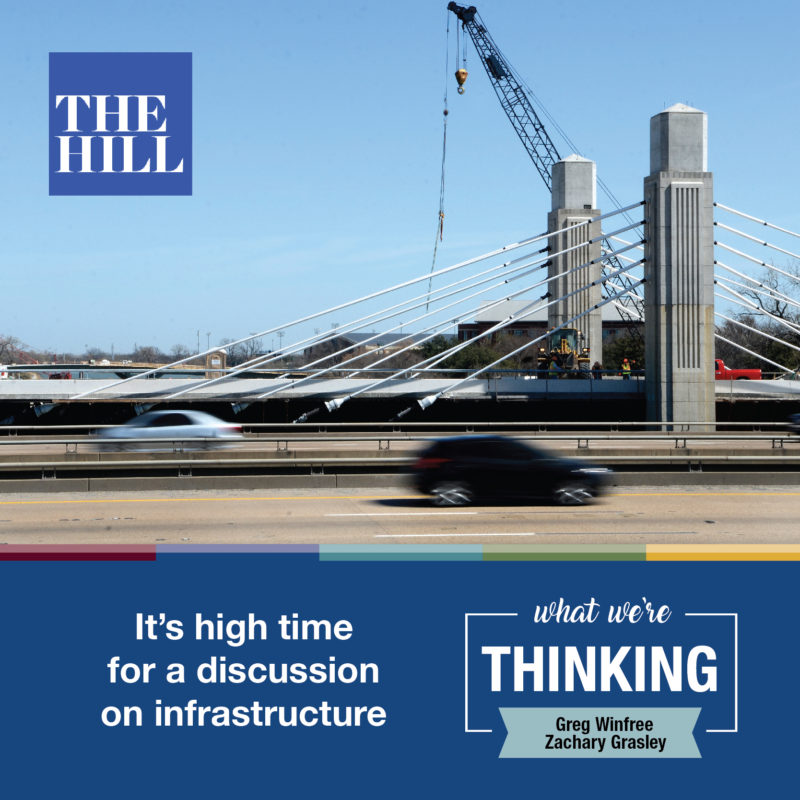 By Gregory Winfree and Zachary Grasley
By Gregory Winfree and Zachary Grasley
In August, we mark 11 years since the Interstate 35 bridge in Minneapolis collapsed into the Mississippi River, killing 13 people and injuring 145 more. For anyone not living there, or otherwise not personally affected by that tragedy, the anniversary will likely pass without a single thought as to its significance.
It’s difficult, after all, to get excited about the topic of infrastructure. In the realm of politics and public policy, it’s the hot button issues that tend to get the most attention. Infrastructure is not one of those. Tragedies, however, have a way of obligating conversation, moving us toward actions we might not otherwise pursue absent the benefit of urgency. That was the case 11 years ago. But, not so much since then.
It’s high time that we make room for infrastructure on our nation’s busy policy agenda, as that vast network provides a critical foundation for virtually every other industry that supports and improves our quality of life. And for three compelling reasons, it needs both our attention and our action now.
The clock is ticking.
Lots of us take infrastructure — particularly our roads and bridges — for granted. We tend to think that everything is alright, until something goes all wrong. Until, say, a disaster like the one in Minneapolis seizes our attention — or, more recently, a disaster like the one in Genoa, Italy, where a major highway bridge collapsed and killed dozens of people.
Events like those serve as reminders that roads and bridges — despite their apparent solid nature and appearance — have limits to their strength, stability, and resilience. Much of what we’re working with is several decades old, so we’re working on borrowed time.
Infrastructure is about more than roads and bridges.
The electric power grid. Airport runways. Sea ports, docks, and canals. Municipal water mains and wastewater treatment systems. Pipelines. Each of these is a form of infrastructure. Each is operating at strained capacity and in need of upgrades and/or repair. Our road and bridge network is essentially competing with all of them for overdue attention.
A draft proposal for addressing the nation’s infrastructure dilemma was introduced by House Transportation and Infrastructure Committee Chairman Bill Shuster (R-Pa.) recently, focusing largely on ensuring the solvency of the Highway Trust Fund. That approach could go a long way in boosting the condition of our roads and bridges, but other infrastructure assets — all with legitimate and urgent needs — would still be waiting in line for scarce funding.
Ah, yes; the money.
This is going to be expensive; there’s no way around that.
The federal motor fuels tax is a primary source of funding for roads and bridges. The tax on gasoline is 18.4 cents per-gallon, no matter what that gallon of gas may cost. The tax amount hasn’t changed since 1993, and it’s not indexed to inflation. Consequently, its value has eroded so much that it pays for only about half of what it once did. And, gas consumption — and the corresponding tax generated — will decline as cars become more fuel-efficient and hybrid and electric vehicles become more common. The wear on roads and bridges, however, will continue unabated.
Raising the tax is an option, though certainly not a popular one. Even so, the recent proposal in Congress would do just that for 10 years before eliminating the tax in favor of a mileage-based fee. But whether funding comes in the form of taxes or user fees, one thing is certain — current funding levels and mechanisms aren’t getting the job done. This is not a question of whether we will have to pay for a renewal of our road and bridge system. It’s more a question of when, and how, and how much.
Granted, this subject is, to many of us, boring. Just try to imagine another topic that’s at the same time interesting to almost no one while being so consequential to just about everyone. But our transportation infrastructure is central to our ability to get to where we live, learn, work, play, and pray. It helps us get to the grocery store, and it helps online orders get to us. It is also in need of upgrade, repair, and expansion.
Roads and bridges, and how we pay for them. Not exactly the stuff of stimulating conversation, but it’s a conversation we need to jump-start and sustain to inform big decisions that lead to meaningful actions. Preferably, before another tragedy compels us.
Gregory Winfree, J.D. is the agency director of the Texas A&M Transportation Institute and a former U.S. assistant secretary of Transportation.
Zachary Grasley, Ph.D., P.E. is a professor at Texas A&M University’s College of Engineering and director of the Center for Infrastructure Renewal.
This article was originally published in The Hill, August 20, 2018.